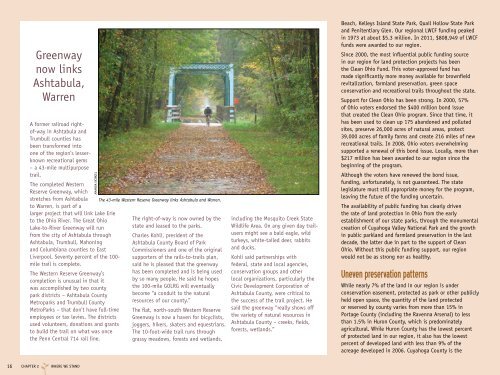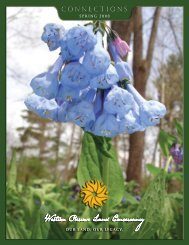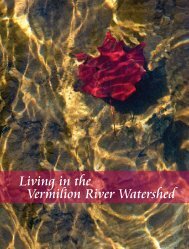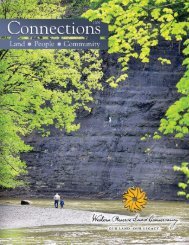Common Ground - Western Reserve Land Conservancy
Common Ground - Western Reserve Land Conservancy
Common Ground - Western Reserve Land Conservancy
You also want an ePaper? Increase the reach of your titles
YUMPU automatically turns print PDFs into web optimized ePapers that Google loves.
Greenway<br />
now links<br />
Ashtabula,<br />
Warren<br />
A former railroad rightof-way<br />
in Ashtabula and<br />
Trumbull counties has<br />
been transformed into<br />
one of the region’s lesserknown<br />
recreational gems<br />
– a 43-mile multipurpose<br />
trail.<br />
The completed <strong>Western</strong><br />
<strong>Reserve</strong> Greenway, which<br />
stretches from Ashtabula<br />
to Warren, is part of a<br />
larger project that will link Lake Erie<br />
to the Ohio River. The Great Ohio<br />
Lake-to-River Greenway will run<br />
from the city of Ashtabula through<br />
Ashtabula, Trumbull, Mahoning<br />
and Columbiana counties to East<br />
Liverpool. Seventy percent of the 100mile<br />
trail is complete.<br />
The <strong>Western</strong> <strong>Reserve</strong> Greenway’s<br />
completion is unusual in that it<br />
was accomplished by two county<br />
park districts – Ashtabula County<br />
Metroparks and Trumbull County<br />
MetroParks – that don’t have full-time<br />
employees or tax levies. The districts<br />
used volunteers, donations and grants<br />
to build the trail on what was once<br />
the Penn Central 714 rail line.<br />
16 CHAPTER 2 WHERE WE STAND<br />
The right-of-way is now owned by the<br />
state and leased to the parks.<br />
Charles Kohli, president of the<br />
Ashtabula County Board of Park<br />
Commissioners and one of the original<br />
supporters of the rails-to-trails plan,<br />
said he is pleased that the greenway<br />
has been completed and is being used<br />
by so many people. He said he hopes<br />
the 100-mile GOLRG will eventually<br />
become “a conduit to the natural<br />
resources of our county.”<br />
The flat, north-south <strong>Western</strong> <strong>Reserve</strong><br />
Greenway is now a haven for bicyclists,<br />
joggers, hikers, skaters and equestrians.<br />
The 10-foot-wide trail runs through<br />
grassy meadows, forests and wetlands,<br />
including the Mosquito Creek State<br />
Wildlife Area. On any given day trailusers<br />
might see a bald eagle, wild<br />
turkeys, white-tailed deer, rabbits<br />
and ducks.<br />
Kohli said partnerships with<br />
federal, state and local agencies,<br />
conservation groups and other<br />
local organizations, particularly the<br />
Civic Development Corporation of<br />
Ashtabula County, were critical to<br />
the success of the trail project. He<br />
said the greenway “really shows off<br />
the variety of natural resources in<br />
Ashtabula County – creeks, fields,<br />
forests, wetlands.”<br />
Beach, Kelleys Island State Park, Quail Hollow State Park<br />
and Penitentiary Glen. Our regional LWCF funding peaked<br />
in 1973 at about $5.3 million. In 2011, $808,949 of LWCF<br />
funds were awarded to our region.<br />
Since 2000, the most influential public funding source<br />
in our region for land protection projects has been<br />
the Clean Ohio Fund. This voter-approved fund has<br />
made significantly more money available for brownfield<br />
revitalization, farmland preservation, green space<br />
conservation and recreational trails throughout the state.<br />
Support for Clean Ohio has been strong. In 2000, 57%<br />
of Ohio voters endorsed the $400 million bond issue<br />
that created the Clean Ohio program. Since that time, it<br />
has been used to clean up 175 abandoned and polluted<br />
sites, preserve 26,000 acres of natural areas, protect<br />
39,000 acres of family farms and create 216 miles of new<br />
recreational trails. In 2008, Ohio voters overwhelming<br />
supported a renewal of this bond issue. Locally, more than<br />
$217 million has been awarded to our region since the<br />
beginning of the program.<br />
Although the voters have renewed the bond issue,<br />
funding, unfortunately, is not guaranteed. The state<br />
legislature must still appropriate money for the program,<br />
leaving the future of the funding uncertain.<br />
The availability of public funding has clearly driven<br />
the rate of land protection in Ohio from the early<br />
establishment of our state parks, through the monumental<br />
creation of Cuyahoga Valley National Park and the growth<br />
in public parkland and farmland preservation in the last<br />
decade, the latter due in part to the support of Clean<br />
Ohio. Without this public funding support, our region<br />
would not be as strong nor as healthy.<br />
Uneven preservation patterns<br />
While nearly 7% of the land in our region is under<br />
conservation easement, protected as park or other publicly<br />
held open space, the quantity of the land protected<br />
or reserved by county varies from more than 15% in<br />
Portage County (including the Ravenna Arsenal) to less<br />
than 1.5% in Huron County, which is predominately<br />
agricultural. While Huron County has the lowest percent<br />
of protected land in our region, it also has the lowest<br />
percent of developed land with less than 9% of the<br />
acreage developed in 2006. Cuyahoga County is the









